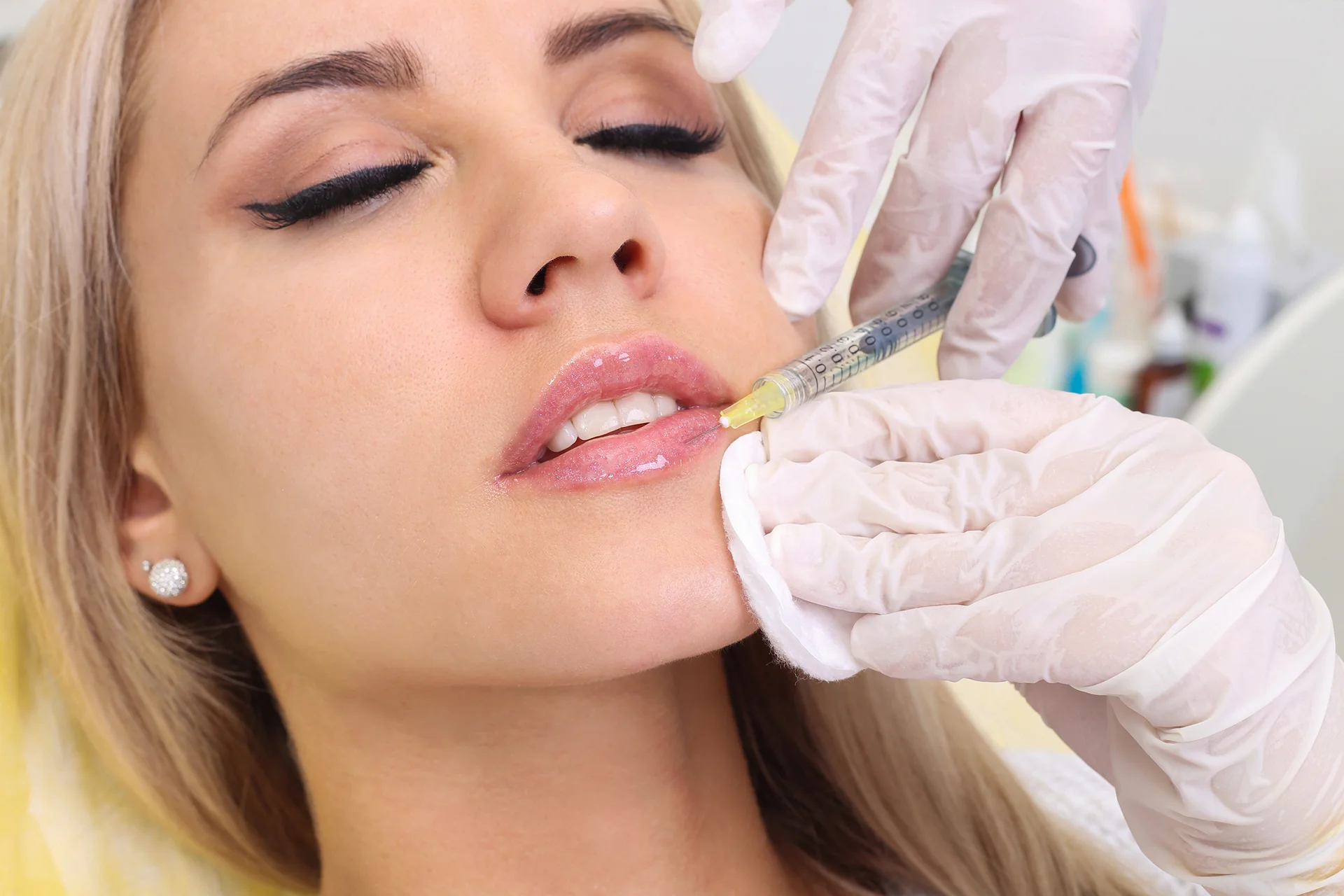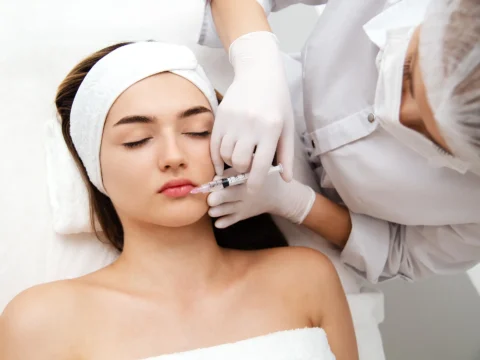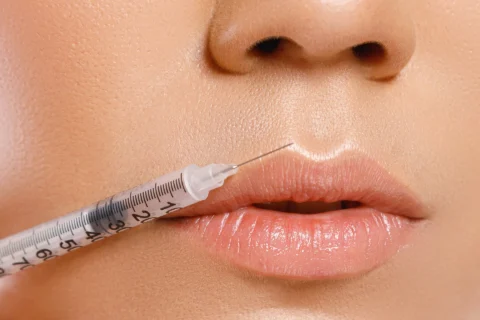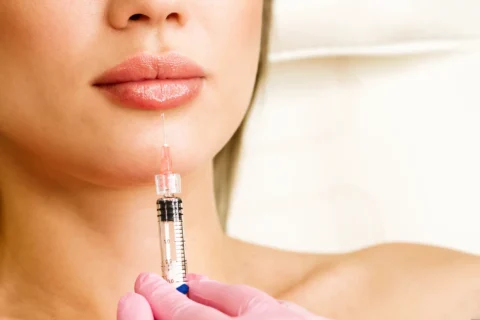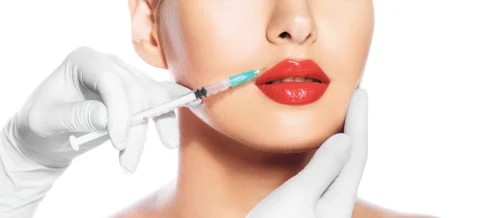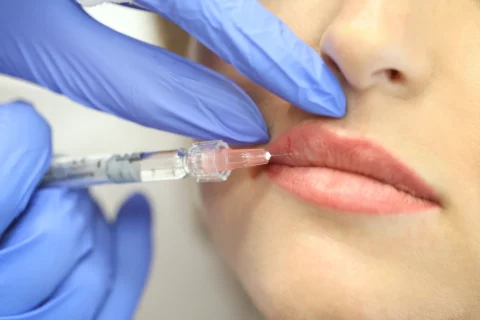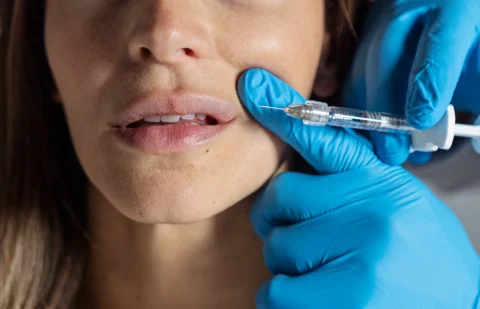Lip filler nodules harshing your look? We’ve got the answers.
Have you noticed strange lumps or bumps on your lips weeks after getting lip fillers? While a bit of swelling is normal at first, persistent nodules or painful masses long after injections may signal complications.
What causes lip granulomas, and is your pout at risk? How can you banish stubborn lumps for smooth, plump lips again? Read on as we explore the causes, symptoms, and treatments for this filler complication. With vigilance and prompt care, you can nip granulomas in the bud.
Bothered by lip filler nodules? We excel at lip refresh redos. Let’s talk.
What is a Lip Filler Granuloma?
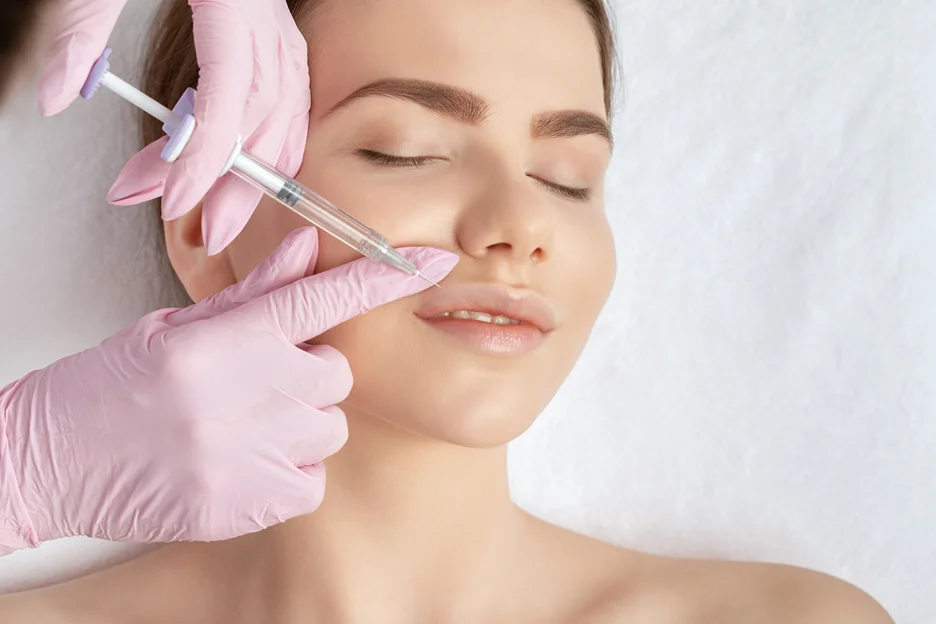
A lip filler granuloma refers to a painful, abnormal lump that can develop after receiving injectable dermal fillers in the lips. Granulomas arise weeks or months after the injection as a delayed immune reaction to the filler material, as discussed in this NCBI study.
Dr. Soni explains that on a microscopic level, granulomas feature clusters of immune cells called macrophages that fuse together to surround the filler, attempting to isolate it.
This leads to concentrated chronic inflammation in one area, as your immune system continues trying to eliminate the perceived foreign invader.
Signs and symptoms include:
- A visible bump or lump on the lips that is swollen and appears red
- Warm, painful, or hardened swelling that grows gradually
- New bumps emerging long after the initial injection
- Lumps that shift when pressed due to not being attached to surrounding lip tissue
What Does a Lip Filler Granuloma Look Like?
A lip filler granuloma typically looks like a nodule or lump in your lips or the surrounding tissue. You may notice the nodule feels firm or cystic when you press on it. It is usually movable under your skin and non-tender.
There may also be some associated swelling, redness, or hardness around the granuloma lump. Dr. Soni advises that on a microscopic level, analysis of the nodules shows:
- The presence of filler material surrounded by giant cells (large inflammatory cells summoned by your immune system)
- Additional inflammatory cells like lymphocytes, macrophages, plasma cells, and eosinophils clustered around the filler.
- Fibrosis (scarring) surrounding the inflammatory reaction as your body walls off the area.
- A “palisading” pattern under the microscope, where the inflammatory cells neatly align in rows around the perceived foreign filler material.
What Causes a Granuloma from Lip Filler?
A granuloma after lip filler injections is caused by an immune response to the injected filler material, triggered by contaminants, poor technique, or patient factors.
Filler Contaminants
- Low-grade filler products may contain impurities like silicone or mineral oil that provoke inflammation. Even small amounts can activate immune cells when injected.
- Using non-sterile filler syringes or poor injection hygiene introduces bacteria that amplify the inflammatory response.
Injection Technique Factors
- Injecting too superficially into the dermis rather than deeper tissues raises risk. The dermis contains more immune cell activity.
- Overcorrecting with excessive filler volume stresses local tissues and incites a reaction.
- Rapid injections or high pressure can damage blood vessels, causing more irritation and swelling.
Patient Risk Factors
- Genetic predispositions like autoimmune conditions increase sensitivity to perceived “foreign” fillers.
- Prior skin infections make patients more prone to delayed hypersensitivity reactions.
- Recent illnesses or infections may also spark granuloma formation afterward.
What are the Symptoms of Filler Granuloma?
The symptoms of a filler granuloma include nodules at injection sites, swelling, redness, pain, asymmetry, hardness around bumps, and movable lumps in treated areas.
- Non-painful nodules or masses in the areas where you received filler injections, occurring weeks to years later, as described in this study. You may notice new bumps emerging long after your treatment.
- Swelling, redness, tenderness, or pain at the specific injection sites. You may feel soreness or sensitivity concentrating in one spot.
- An asymmetric or irregular appearance of the treated areas. One section of your lips may develop more pronounced bumps and lumpiness.
- Firmness, hardness, or induration around the bumps and nodules.
- New lumps that feel movable when pressed, as they are not attached to the surrounding lip tissue.
Why Are There Lumps in My Lip After Lip Filler?
Lumps and bumps after receiving lip filler injections are common and usually temporary. However, there are a few potential causes to be aware of:
1. Swelling and Bruising
Some swelling and bruising at the injection sites are normal side effects that Dr. Soni says you can expect after lip filler treatment. This can make your lips feel uneven or lumpy for the first few days or weeks as the area recovers.
Gently massaging your lips can help smooth out the filler and reduce swelling. Dr. Soni also recommends applying ice packs to the treated areas to alleviate swelling and lumpiness. Any bruising and swelling should resolve on its own within 1-2 weeks.
2. Uneven Filler Distribution
In some cases, Dr. Soni explains the filler may be inadvertently injected unevenly or migrate slightly out of position when you smile or eat. This can lead to regions of too much or too little filler, causing a lumpy texture.
Massaging your lips and allowing time for the filler to settle can often correct this. If any lumps persist, Dr. Soni may use hyaluronidase injections to gently dissolve excess filler for smoother results.
3. Allergic Reaction
Rarely, some patients may have an allergic reaction or granuloma formation from the filler material itself. According to Dr. Soni, this can result in firm, tender lumps that don’t improve on their own. Seeking prompt medical care is important, as steroid or hyaluronidase injections may be required to treat this type of adverse reaction.
4. Improper Injection Technique
Dr. Soni emphasizes that improper filler injection technique can increase the chances of a lumpy outcome. Selecting an experienced, qualified injector is important for this sole reason.
What are Lip Filler Nodules?
Lip filler nodules refer to small lumps or bumps that can form after you receive dermal filler injections in your lips. They represent a potential side effect of the lip augmentation procedure.
Dr. Soni advises that nodules may occur due to:
- Swelling and bruising at the injection site during the normal healing process. These should resolve within 1-2 weeks.
- The filler product clumping or becoming unevenly distributed. This can happen if too much filler is injected or your facial movements displace the filler. Gently massaging your lips can help smooth these areas.
- In rare cases, an inflammatory reaction by your body to the filler as a foreign substance, resulting in granuloma formation. Modern hyaluronic acid fillers lower this risk.
- Very rarely, infection at the injection site.
According to Dr. Soni, minor swelling, bruising, and small temporary lumps are common and normal after lip filler injections. However, more significant or persistent nodules are not normal and may indicate an issue with the filler placement or a complication.
Dr. Soni recommends that any nodules lasting longer than 2 weeks, or ones that are growing larger or more painful, warrant medical evaluation to determine the underlying cause and appropriate correction. Let our team know if you have any concerns.
Can Granuloma Form from Lip Filler Nodules?
Yes, granulomas can potentially form from lip filler nodules that develop after you receive the injections. As a reminder, lip fillers are dermal fillers injected into your lips to add volume and fullness. Nodules, which are benign bumps or lumps, are a common temporary side effect of lip fillers.
However, in some cases, Dr. Soni explains that these nodules can progress to form granulomas.
Dr. Soni advises that granuloma formation is an uncommon but potential late complication of lip fillers, occurring in 0.1-1% of cases. Granulomas usually develop months or even years after your initial lip filler injection, with an average onset of about 3 years based on medical reviews.
Importantly, not all nodules turn into granulomas. However, histological analysis shows many lip filler nodules removed from patients do contain foreign body granulomas upon examination.
The granulomas are thought to represent a delayed hypersensitivity reaction by your immune system to the filler material itself.
Based on our research, certain fillers like silicone seem more prone to causing granulomas compared to modern hyaluronic acid fillers.
How is Lip Filler Granuloma Treated?
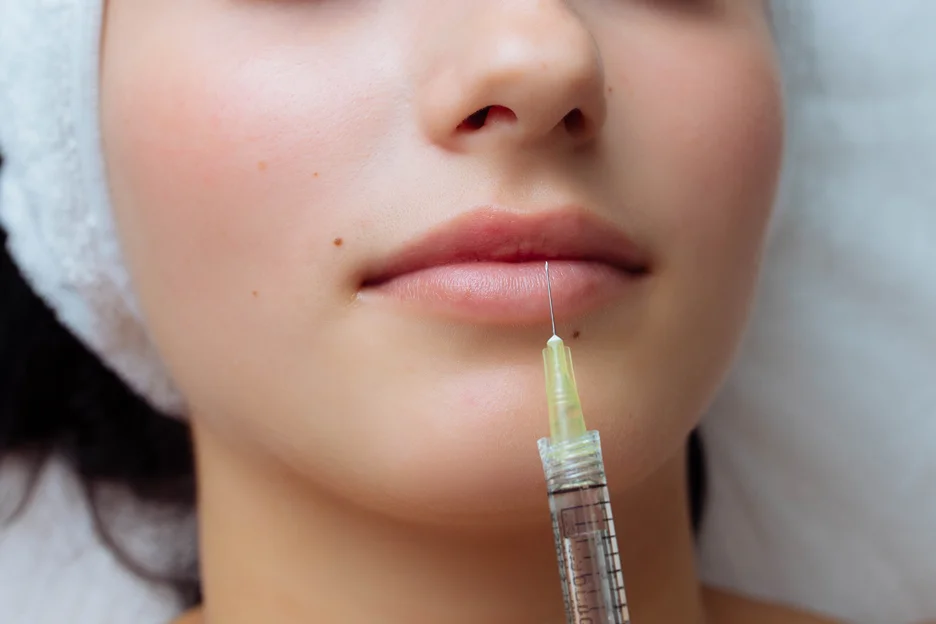
Lip filler granulomas are treated with intralesional steroid injections, hyaluronidase to dissolve hyaluronic acid fillers, antibiotics for infection, and surgical excision for severe cases.
1. Intralesional Corticosteroid Injections
Dr. Soni advises that injecting corticosteroid medications directly into the granuloma is considered first-line treatment. Medications like triamcinolone or betamethasone are used.
The steroid helps resolve the inflammation and reduces the size of the granuloma. Typically, a series of injections every 4-6 weeks for several months is needed to fully dissipate the lesion.
The 2022 systematic review found that intralesional steroid injections and hyaluronidase injections are effective treatments for delayed-onset granulomas from lip fillers. The steroids help resolve inflammation while the hyaluronidase breaks down the hyaluronic acid filler material.
2. Hyaluronidase
For granulomas caused by hyaluronic acid fillers, Dr. Soni may recommend hyaluronidase. This enzyme breaks down and dissolves the filler material when injected into the granuloma. Combining hyaluronidase with intralesional steroids can help facilitate resolution.
3. Oral Antibiotics
If infection is contributing to the granuloma, Dr. Soni may prescribe oral antibiotics like doxycycline along with intralesional steroid injections. The antibiotics help resolve associated inflammation.
4. Surgical Excision
In severe or refractory cases, granulomas may need surgical removal. However, Dr. Soni notes this can be challenging given granulomas often invade surrounding tissues and lack defined borders. Excision can potentially leave scarring or deformity.
A 2015 paper explains surgical excision of granulomas can be challenging due to ill-defined borders and the risk of scarring/deformity, which is why it’s almost always a last resort.
The prognosis is generally good with appropriate treatment applied promptly. Most granulomas resolve within a few months, though some take longer.
FAQs
How long do lumps last after lip filler?
Lumps after lip filler typically resolve within 2-4 weeks as swelling and bruising subside; if persistent beyond 1 month.
Can I get lip fillers if I have a cleft lip?
Yes, you can get lip fillers with a cleft lip but choose an experienced injector and start with a conservative amount due to scar tissue; avoid overfilling to prevent more lumpiness.
Can I get lip filler after a lip flip?
Yes, you can get lip filler after a lip flip but wait 1-2 weeks for swelling to resolve so your injector can properly assess your lips; combine treatments for a subtle plumping effect.
Can lip filler cause mucocele?
Yes, lip filler can potentially cause mucocele by obstructing salivary gland ducts but this is uncommon; see your injector if a cyst forms for drainage or hyaluronidase.
Are delayed dermal filler granulomas more common since COVID-19?
No evidence shows delayed granulomas are more common after filler since COVID-19; proper technique minimizes this rare risk so see an experienced injector.
Beat nodules. Achieve fuller lips. Our specialists at Ethos Spa will carefully evaluate and craft a personalized treatment plan. Book a consultation now!

